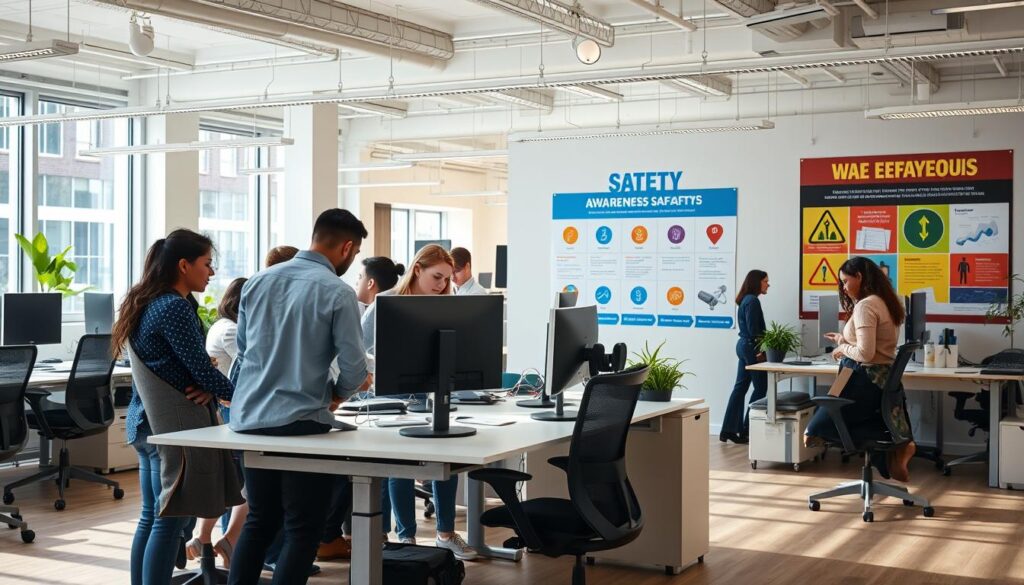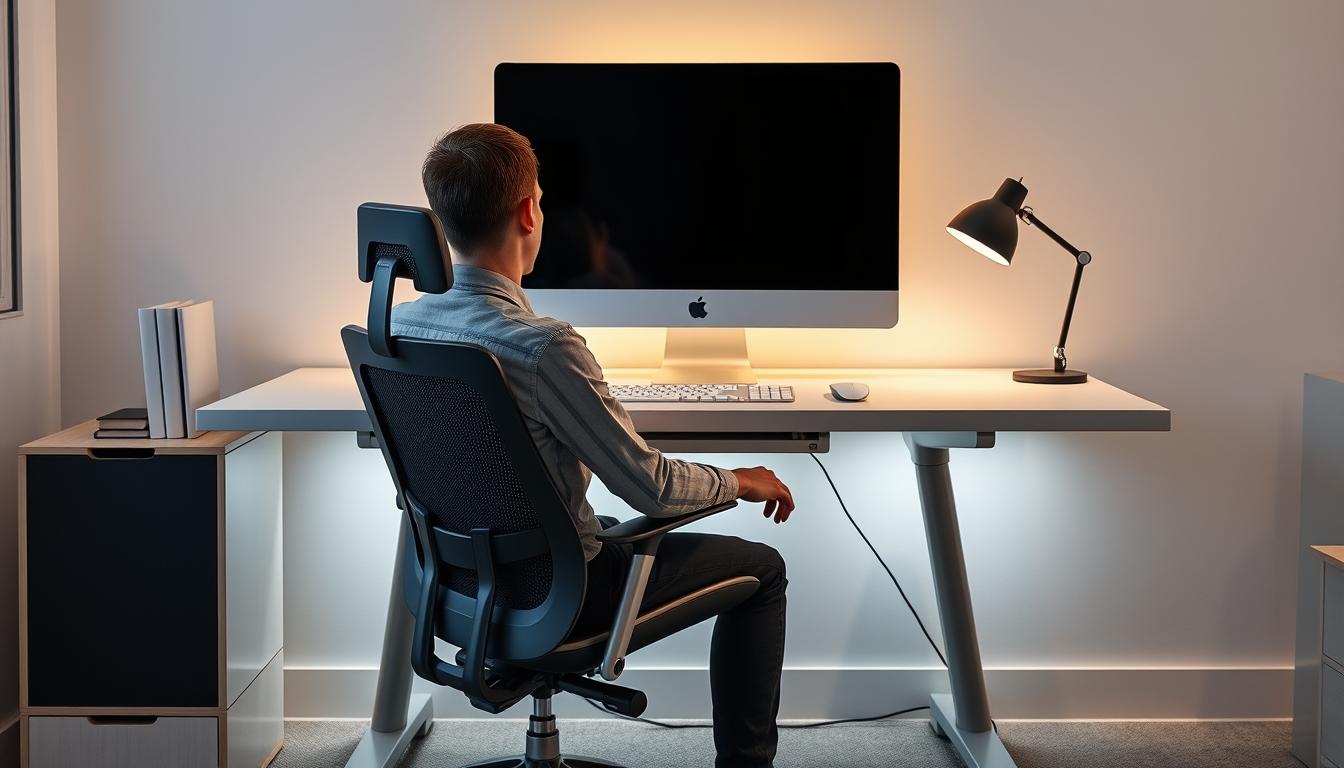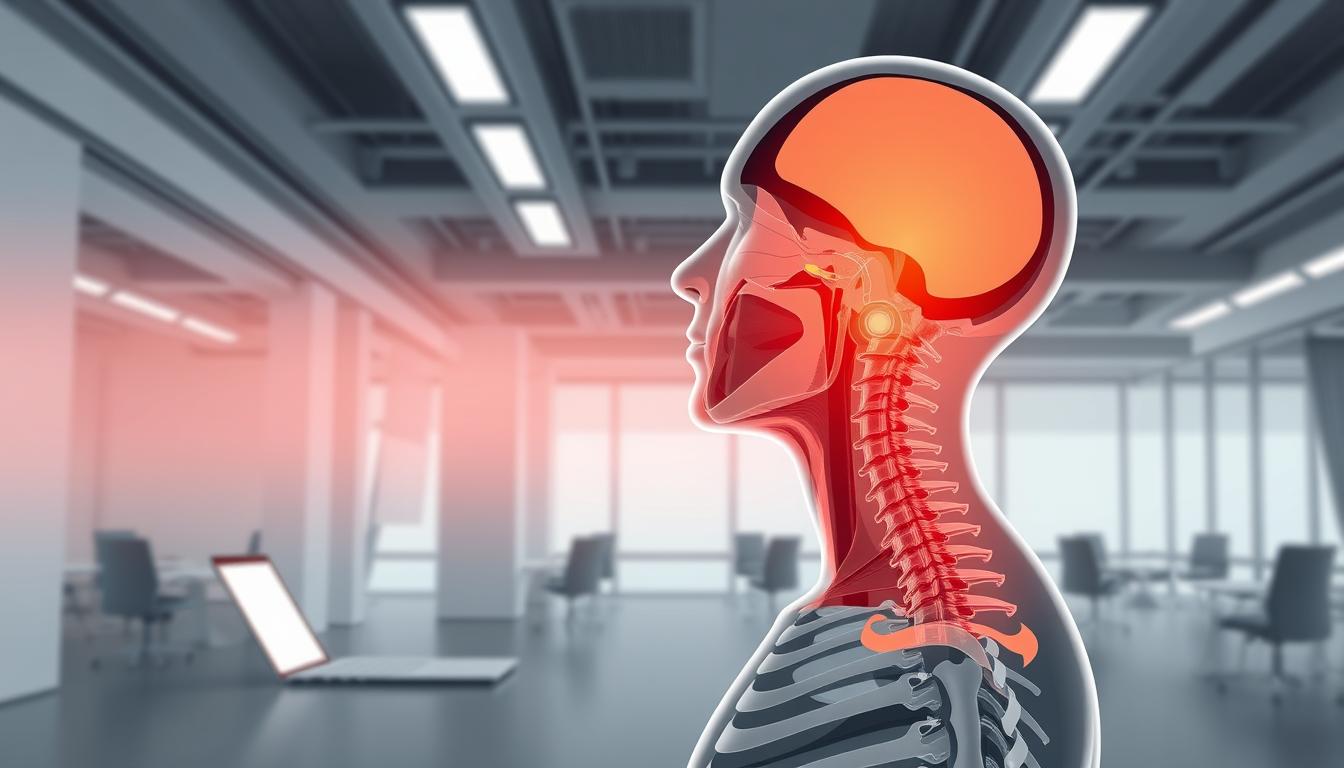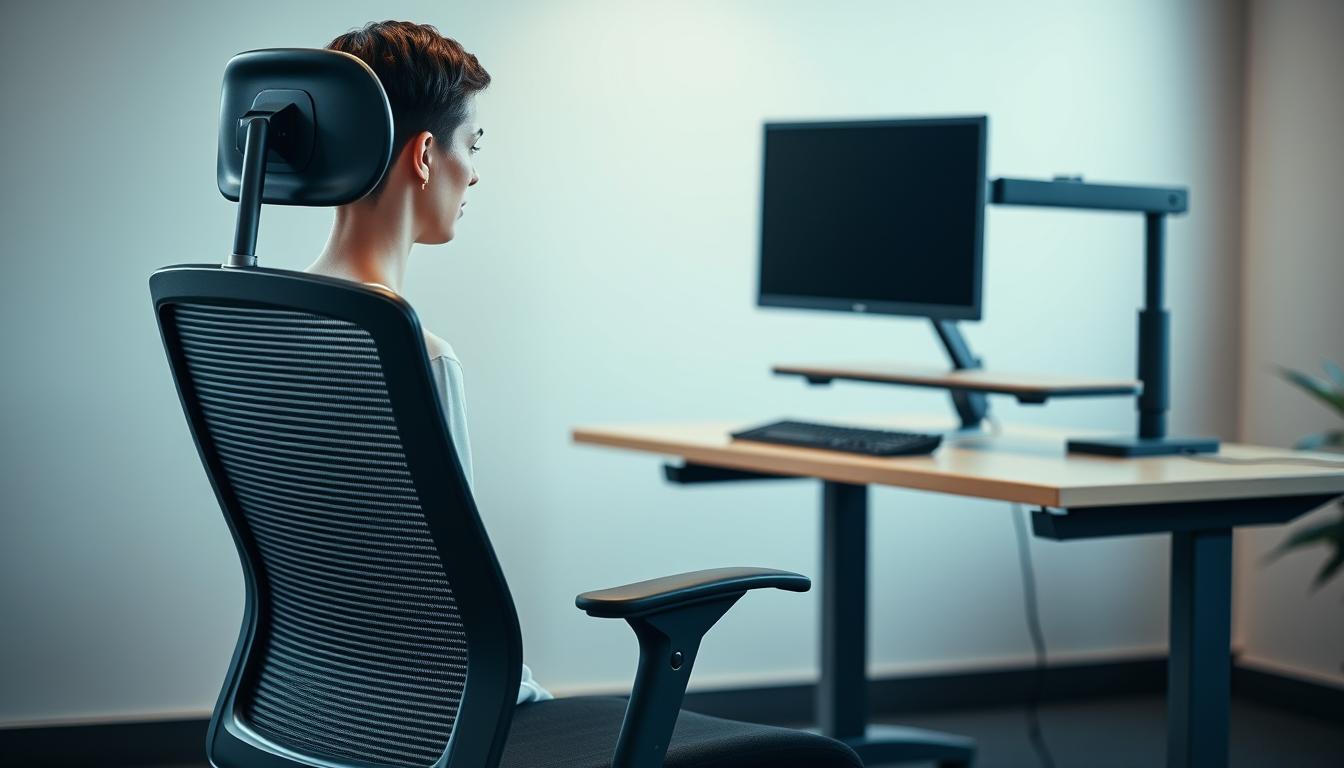In our fast-moving work settings, a detailed workplace ergonomic assessment is key. It involves a careful process that boosts worker comfort and productivity. By focusing on ergonomics, companies reduce injury risks and emphasize safety.
This results in a better workplace that values employee health. Our guide will offer essential tips for conducting successful assessments. It aims to help your organization do well while putting employee health first.
Understanding Ergonomics and Its Importance in the Workplace
Learning about ergonomics helps us understand its role in making workspaces safer and better. This science is all about arranging work areas and tools to meet workers’ needs. Making ergonomics a priority means healthier, safer employees who can perform their best.
Definition of Ergonomics
Ergonomics focuses on making work easier and safer for everyone. It designs equipment and tasks to fit what humans can do comfortably. This way, workplaces can lower the risks of injury and build a healthier work setting.
Why Ergonomics Matters for Employee Health and Safety
Ergonomics is really important for keeping workers safe. It fixes bad workstation designs and cuts down on dangers that can hurt workers. By tackling these issues, workers stay healthier, miss fewer days, and work better.
Overview of Musculoskeletal Disorders (MSDs)
Musculoskeletal disorders are injuries from making the same movements over and over, sitting wrong, or bad workstation design. They cause a lot of workers to miss work and hurt employee health. By dealing with these dangers, companies can lower the chance of these injuries and support a better workplace.
What is a Workplace Ergonomic Assessment?
An ergonomic assessment in the workplace is essential for spotting and lessening risks. It looks closely at how workers interact with their surroundings. The goal is to reduce hazards that might cause injuries at work.
Definition and Purpose of Ergonomic Assessments
An ergonomic assessment checks the setup at work, what employees do, and the environment around them. Its main aim is to match workstations and tasks with what people can do. This makes things safer and more comfortable, cutting down on injury risks. Doing these assessments well helps prevent workplace injuries and makes a safer work atmosphere.
Potential Benefits for Employees and Employers
Doing ergonomic checks brings lots of good points. Workers enjoy better comfort and get more done, making them happier with their jobs. Employers see fewer costs from injuries, like medical bills and lost work time. Good ergonomic practices also lower the chance of being out sick from problems like musculoskeletal disorders (MSDs), showing their value.
Common Ergonomic Hazards in Work Environments
Many ergonomic risks can hurt the health and work of employees. Some common troubles include:
- Repetitive motions that can cause strain
- Awkward postures leading to discomfort
- Poorly designed furniture affecting the body
- Bad lighting making it hard to see and focus
Finding and fixing these issues is vital. It helps make the workplace safer and healthier for everyone.
Workplace Ergonomic Assessment: A Step-by-Step Guide
A comprehensive ergonomic assessment process has several important steps. It ensures a good review of workplace conditions. This approach helps find risks and improve employee well-being.
Step 1: Review Existing Workplace Data
Start by looking closely at workplace data. Check injury reports, worker’s compensation claims, and safety logs. This helps identify risky areas and common injury trends, setting the stage for deeper assessment.
Step 2: Select Assessment Tools
Picking the right tools is key. Use metrics from tools like the NIOSH Lifting Equation, RULA, and REBA. They guide the assessment and help evaluate risks in the workplace.
Step 3: Gather Subjective Employee Feedback
Talking to employees is vital. Get their thoughts through chats or surveys. Focus on their comfort and safety issues. Their feedback can highlight ergonomic problems.
Step 4: Collect Objective Data through Site Visits
Visit the site to see conditions firsthand. Observe how employees use equipment to collect real-time data. This step adds valuable information for analysis, showing what needs action.
Step 5: Analyze Data and Identify Risks
Put together and look over all the data. Make a list of ergonomic risks, prioritized by urgency. This step clarifies which areas need changes to improve ergonomics.
Identifying Common Ergonomic Risk Factors
It’s key to know the ergonomic risks that affect workplace comfort for a safe and efficient space. Challenges come from doing the same thing over and over, staying still, and the setting. Spotting these risks helps make plans that boost productivity and cut down on injuries.
Repetitive Motions and Awkward Postures
Doing the same task many times can hurt muscles and joints. If workers keep doing the same tasks, they get tired, and injury risk goes up. Also, awkward ways of standing or moving can make things worse. They add stress and discomfort. Checking and changing how things are done can reduce these risks.
Static Forces and Prolonged Sitting
Sitting for too long is bad for workplace comfort. The pressure on the body can cause pain and long-term problems like chronic back pain. Workstations that can be adjusted let workers change how they stand or sit. This promotes better spine health and less pain from sitting too much.
Environmental Factors Affecting Comfort and Productivity
The work setting greatly affects how comfortable and productive employees are. Things like light, heat, and noise really change how well someone can work. Making sure these parts of the environment are just right makes a better and less distracting workspace.
Implementing Changes Based on Assessment Findings
Creating a plan that improves work comfort needs a clear strategy after assessing the situation. It’s key to pick specific fixes that make work better and healthier for everyone. This step is vital because it prepares for important changes and gets workers involved.
Developing an Ergonomic Improvement Plan
First, make a detailed plan for ergonomic improvements. This plan should list clear goals, steps to take, and who does what. Everything in the plan must be based on what was found during the assessment. This makes sure the plan targets the right issues found in the review.
Types of Modifications to Consider
Think about different ways to make the workplace better for health, such as:
- Adjustable furniture that fits everyone’s needs.
- Ergonomic tools like special keyboards, mice, and desks that let you stand.
- Training on how to sit and move right.
- Changing how work is done to lessen the same movements and lower stress.
Engaging Employees in the Change Process
Getting workers involved is key to making ergonomic changes work well. Asking for their thoughts during planning and doing helps everyone work together. By making sure workers are part of the decision, the new changes will better match their needs. This also helps everyone agree to the changes more easily.
The Role of Management in Promoting Workplace Ergonomics
Management plays a key role in making sure ergonomics is a priority at work. By taking responsibility, leaders make sure that ergonomic plans work well to improve employee health.
Creating a Culture of Safety and Comfort
Building a strong safety culture starts with management caring about health and safety rules. They should provide things like adjustable desks and tools that lower stress. This approach makes employees take their health seriously, creating a place where everyone trusts and talks to each other.
Training and Awareness Programs for Employees
Ergonomic training helps employees know the right way to do their jobs. These programs teach about ergonomics and stress the need to report discomfort early. When management supports these trainings, workers take an active part in keeping their workplace safe and smooth.

Monitoring and Evaluating Ergonomic Changes
It’s vital to track ergonomic changes at work to ensure they improve employee comfort and productivity. Goals should be clear for these changes. They should measure both quick results and long-term impacts on health and safety.
Setting Objectives for Improvement
Companies need to set specific goals to properly evaluate ergonomic changes. These objectives might include:
- Reducing employee discomfort or pain.
- Boosting productivity levels.
- Getting feedback on ergonomic practices from staff.
Having clear goals helps in deciding how often to evaluate changes. It lets companies see if the ergonomic improvements are working as intended.
Conducting Follow-Up Assessments
Doing regular check-ups on ergonomic changes is important. These checks should look at:
- How comfortable and productive employees feel after changes.
- New ergonomic problems that could show up later.
- Making updates based on what the data shows.
This ongoing process helps businesses keep making positive changes. It ensures workplaces stay safe and efficient.
The Future of Workplace Ergonomic Assessments
The way we look at ergonomic assessments in offices is changing a lot. With more people working from home or in a mix of home and office, getting our workspaces right is more important than ever. This means we need better ergonomic solutions to make sure everyone is comfy no matter where they work.
Trends in Remote and Hybrid Workspaces
As more folks work from home, companies have to check if home offices are set up right. Bad setups can cause discomfort and even hurt your health over time. Looking ahead, ergonomic trends will aim to:
- Provide tips for the best home office setups
- Promote taking breaks and doing ergonomic checks
- Offer online tools for checking if your workspace is comfy
Emerging Technologies in Ergonomics
New tech is making hybrid workspaces safer and better. Things like smart furniture that changes for what you need and apps that give feedback on how you’re working are changing the game. Some cool new tools include:
- Desks that move up and down to help you stand and move around
- Gadgets you wear that remind you to sit up straight
- Apps that look at how you work and suggest ways to make it better
These tech advances help workers stay healthy. They also make everyone more productive in the changing world of work.
Conclusion
An ergonomic assessment summary shows how important ergonomics are for keeping employees healthy and safe. By looking at and fixing ergonomic risks, companies can make their workplaces safer. This doesn’t just make things more comfortable in the short term. It’s a lasting investment in the health of employees.
It leads to happier employees and less time off work. Companies should keep checking their ergonomic setups regularly. They should make changes based on what they find. This shows they care about making a sustainable place where people are happy to work.
As companies grow, they need to keep their ergonomic practices up to date. This will help keep their workforce healthy and more involved in their work. In the end, focusing on ergonomics is more than just following rules.
It means seeing the value of people in getting work done. By making ergonomic assessments a priority, companies build a culture that puts safety and health first. This makes sure that their most important resource—their employees—are looked after and able to do their best work.



